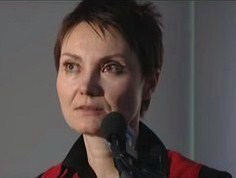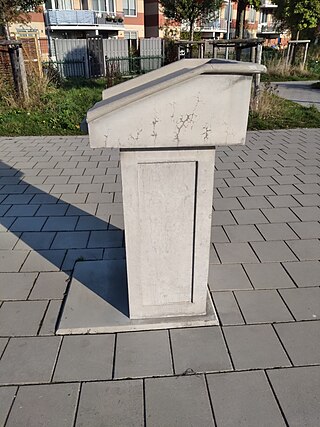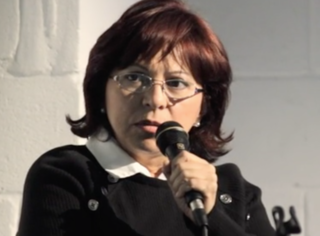
Katarzyna Kozyra is a Polish video artist. She studied German studies at the University of Warsaw (1985–1988). In 1993, she also graduated from the Academy of Fine Arts in Warsaw where she studied sculpture and Hochschule für Graphik und Buchkunst in Leipzig. Kozryra received a Paszport Polityki award in 1997 as the most promising artist in Poland. She has exhibited internationally since 1997, at venues including Brown University and Carnegie International in the U.S.

Hannah Wilke was an American painter, sculptor, photographer, video artist and performance artist. Wilke's work is known for exploring issues of feminism, sexuality and femininity.

Teresita Fernández is a New York-based visual artist best known for her public sculptures and unconventional use of materials. Her work is characterized by an interest in perception and the psychology of looking. Her experiential, large-scale works are often inspired by landscape and natural phenomena as well as diverse historical and cultural references. Her sculptures present spectacular optical illusions and evoke natural phenomena, land formations, and water in its infinite forms.

Orshi Drozdik is a feminist visual artist based in New York City. Her work consists of drawings, paintings, photographs, etchings, performances, videos, sculptures, installations, academic writings and fiction, that explore connected themes, sometimes over an extended period. Through her work, organized into several topics, she explores themes that undermine the traditional and erotic representation of women: Individual Mythologies,Adventure in Tecnos Dystopium, and Manufacturing the Self. She is influenced by Valéria Dienes, János Zsilka, Susan Sontag, Ludwig Wittgenstein, Luce Irigaray, Walter Benjamin, and Michel Foucault, among others. Her working method: critical analysis of meaning, influenced her contemporaries, her students and later generations of women artists. The art historian László Beke noted in an interview realized by Kata Krasznahorkai in 2017 that "Orsolya Drozdik is the first feminist artist in Hungary".
Minnette Vári is a South African artist known primarily for her video installations. Born in Pretoria, Vári studied fine arts at the University of Pretoria where she obtained her master's degree. She lives and works in Johannesburg.

Dannielle Tegeder is a contemporary artist who works with installation, animation and sound and is best known for her abstract paintings and drawings. She lives in Brooklyn, New York and maintains a studio at The Elizabeth Foundation in Times Square, Manhattan.

Nene Humphrey is a New York-based multidisciplinary artist. Her work has been compared to that of Kiki Smith, Janine Antoni, Petah Coyne, and Louise Bourgeois. She has lived and worked in New York since 1978. Humphrey’s work explores the body, loss, the neuroscience of emotion, and the beauty inherent in both. The integration of art and science is fundamental to Humphrey’s art practice, which often takes the form of iterative research-based projects.

Cecilia Vicuña is a Chilean poet and artist based in New York and Santiago, Chile.
Monika Bravo is a multi-disciplinary artist born in Bogotá, Colombia, who lives and works in New York City, New York. Her work has been internationally exhibited, including at Stenersen Museum in Oslo; Seoul's International Biennial of New Media Art; Bank of the Republic in Bogotá; New Museum and El Museo del Barrio in New York City and Site Santa Fe. Her work has received acclaim including a 1999 New York Times review which called her piece Synchronicity a "standout...small, beautifully blurry video images of boats plowing through New York Harbor..."
Leandro Soto was a Cuban-American multidisciplinary visual/installation and performance artist. He was also a set and costume designer for theater and film. Soto studied at Escuela Nacional de Arte National Art Schools (Cuba) and Instituto Superior de Arte, University of Havana. As an educator he taught and lectured at various Higher Education institutions in the U.S. and abroad. Soto also founded a creative workshop, El Tesoro de Tamulte, in Tabasco, Mexico, from which professional artists emerged.

Nan Hoover was a Dutch/American-expatriate artist who is known for her pioneering work in video art, photography and performance art. She spent almost four decades living and working in the Netherlands. She also used the mediums of drawing, painting, photography and film and created art objects and sculptures. One of the main themes of her art was light and motion. The rigorous, minimalist handling of her means as well as the intense concentration with which she performed within spaces of light and shadow are the most salient characteristics of her artistic work.

Amalia Pica is a London-based Argentinian artist who explores metaphor, communication, and civic participation through sculptures, installations, photographs, projections, live performances, and drawings.
Johanna Calle is an artist born in Bogotá, Colombia, in 1965. She is based in Bogotá.
Ella Fontanals-Cisneros is a Cuban-born philanthropist and art collector with an abiding passion, and discerning eye for contemporary art and design. Born in Cuba and raised in Venezuela, her vision has made a significant impact on the Miami arts community and arts organizations around the globe. She is the founder and honorary president of the Cisneros Fontanals Art Foundation (CIFO).
Sabine Hornig is a German visual artist and photographer who lives and works in Berlin. Her work in photography, sculpture, and site-specific installation art is known for her interpretations of modernist architecture and contemporary urban life. Her work has appeared in solo exhibitions throughout the world, including Double Transparency at Art Unlimited Basel in Switzerland (2014) and Projects 78 at the Museum of Modern Art in New York (2003), and in numerous group exhibitions at institutions like the J.Paul Getty Museum in Los Angeles and ICA London.
Meg Webster is an American artist from San Francisco working primarily in sculpture and installation art. While her works span multiple media, she is most well known for her artworks that feature natural elements. She is closely affiliated with Post-Minimalism and the Land Art movement and has been exhibiting her work since 1980.

María Evelia Marmolejo is a Colombian radical feminist performance artist, later based in Madrid and New York City. She is credited by the Colombian scholar María Lovino with staging the first work of feminist performance art in Colombia, in 1981. She is best known for discussing controversial themes such as political oppression, feminism, environment, and socioeconomic issues within her performances.
Elena Asins was a prominent visual artist, writer, lecturer and critic. Her plastic language was based on computer systematic calculation. Asins pioneered the convergence between theoretical computer science and the minimal and geometrical tendencies of the 1960s. She belongs to the first generation of artists using computers to generate art.
Dolores "Loló" Soldevilla Nieto (1901–1971) was a Cuban visual artist primarily known for her role in concrete art.
Suwon Lee is a Korean-Venezuelan artist based in Madrid, Spain.










